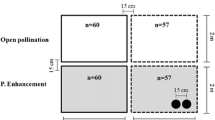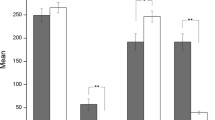Abstract
The roles of herbivory and pollination success in plant reproduction have frequently been examined, but interactions between these two factors have gained much less attention. In three field experiments, we examined whether artificial defoliation affects allocation to attractiveness to pollinators, pollen production, female reproductive success and subsequent growth in Platanthera bifolia L. (Rich.). We also recorded the effects of inflorescence size on these variables. We studied the effects of defoliation on reproductive success of individual flowers in three sections of inflorescence. Defoliation and inflorescence size did not have any negative effects on the proportion of opened flowers, spur length, nectar production or the weight of pollinia. However, we found that hand-pollination increased relative seed production and defoliation decreased seed set in most cases. Interactions between hand-pollination and defoliation were non-significant indicating that defoliation did not affect female reproductive success indirectly via decreased pollinator attraction. Plants with a large inflorescence produced relatively more seeds than plants with a small inflorescence only after hand-pollination. The negative effect of defoliation on relative capsule production was most clearly seen in the upper sections of the inflorescence. In addition to within season effects of leaf removal, defoliated P. bifolia plants may also have decreased lifetime fitness as a result of lower seed set within a season and because of a lower number of reproductive events due to decreased plant size (leaf area) following defoliation. Our study thus shows that defoliation by herbivores may crucially affect reproductive success of P. bifolia.
Similar content being viewed by others
References
Ackerman J.D. and Montalvo A.M. (1990). Short- and long-term limitations to fruit production in a tropical orchid. Ecology 71:263–272
Aizen M.A. and Raffaele E. (1996). Nectar production in Alstroemeria aurea: responses to level and pattern of flowering shoot defoliation. Oikos 76:312–322
Aizen M.A. and Raffaele E. (1998). Flowering shoot defoliation affects pollen grain size and postpollination pollen performance in Alstroemeria aurea. Ecology 79:2133–2142
Ayre D.J. and Whelan R.J. (1989). Factors controlling fruit set in hermaphroditic plants: studies with the Australian Proteaceae. Trends in Ecology and Evolution 4:267–272
Boose D.L. (1997). Sources of variation in floral nectar production rate in Epilobium canum (Onagraceae): implications for natural selection. Oecologia 110:493–500
Brunet J. (1996). Male reproductive success and variation in fruit and seed set in Aquilegia caerulea (Ranunculaceae). Ecology 77:2458–2471
Casper B.B. and Niesenbaum R.A. (1993). Pollen versus resource limitation of seed production: A reconsideration. Current Science 65:210–214
Cresswell J.E., Hagen C. and Woolnough J.M. (2001). Attributes to individual flowers of Brassica napus L. are affected by defoliation but not by intraspecific competition. Annals of Botany 88:111–117
Ehrlén J. (1991). Why do plants produce surplus flowers? A reserve-ovary model. American Naturalist 138:918–933
Frazee J.E. and Marquis R.J. (1994). Environmental contribution to floral trait variation in Chamaecrista fasciculata (Fabaceae: Caesalpinoideae). American Journal of Botany 81:206–215
Gronemeyer P.A., Dilger B.J., Bouzat J.L. and Paige K.N. (1997). The effects of herbivory on paternal fitness in scarlet gilia: better moms also make better pops. American Naturalist 150:592–602
Hambäck P.A. (2001). Direct and indirect effects of herbivory: Feeding by spittlebugs affects pollinator visitation rates and seedset of Rudbeckia hirta. Ecoscience 8:45–50
Hendrix S.D. (1988). Herbivory and its impact on plant reproduction. In: Lovett Doust J. and Lovett Doust L. (eds), Plant reproductive ecology. Oxford University Press, New York, pp. 246–263
Inoue K. (1985). Reproductive biology of two Platantherans (Orchidaceae) in the Island of Hachijo. Japanese Journal of Ecology 35:77–83
Inoue K. (1986a). Experimental studies on male and female reproductive success: effects of variation in spur length and pollinator activity on Platanthera mandarinorum ssp. hachijoensis (Orchidaceae). Plant Species Biology 1:207–215
Inoue K. (1986b). Different effects of sphingid and noctuid moths on the fecundity of Platanthera metabifolia (Orchidaceae) in Hokkaido. Ecological Research 1:25–36
Krupnick G.A., Weis A.E. and Campbell D.R. (1999). The consequences of floral herbivory for pollinator service to Isomeris arborea. Ecology 80:125–134
Kudo G., Maeda T. and Narita K. (2001). Variation in floral sex allocation and reproductive success within inflorescences of Corydalis ambigua (Fumariaceae): pollination efficiency or resource limitation?. Journal of Ecology 89:48–56
Ladio A.H. and Aizen M.A. (1999). Early reproductive failure increases nectar production and pollination success of late flowers in south Andean Alstroemeria aurea. Oecologia 120:235–241
Lawrence W.S. (1993). Resource and pollen limitation: plant size-dependent reproductive patterns in Physalis longifolia. American Naturalist 141:296–313
Leeson E., Haynes C. and Wells T.C.E. (1991). Studies of the phenology and dry matter allocation of Dactylorhiza fuchsii. In: Wells T.C.E and Willems J.H. (eds), Population ecology of terrestrial orchids.SPB Academic Publishing bv, The Hague, pp. 125–138
Lehtilä K. and Strauss S.Y. (1997). Leaf damage by herbivores affects attractiveness to pollinators in wild radish, Raphanus raphanistrum. Oecologia 111:396–403
Lehtilä K. and Strauss S.Y. (1999). Effects of foliar herbivory on male and female reproductive traits of wild radish, Raphanus raphanistrum. Ecology 80:116–124
Mattila E. (2000). The effects of water stress and pollen availability on reproductive success of Platanthera bifolia (Orchidaceae). Det Norske videnskaps-Akademi. I. Matematisk Naturvidenskapelige Klasse. Skrifter, Ny serie 39:83–90
Mattila E. and Kuitunen M.T. (2000). Nutrient versus pollination limitation in Platanthera bifolia and Dactylorhiza incarnata (Orchidaceae). Oikos 89:360–366
McKone M.J. (1989). Intraspecific variation in pollen yield in bromegrass (Poaceae: Bromus). American Journal of Botany 76:231–237
Mothershead K. and Marquis R.J. (2000). Fitness impacts of herbivory through indirect effects on plant-pollinator interactions in Oenothera macrocarpa. Ecology 81:30–40
Mutikainen P. and Delph L.F. (1996). Effects of herbivory on male reproductive success in plants. Oikos 75:353–358
Nilsson L.A. (1978). Pollination ecology and adaptation in Platanthera chlorantha (Orchidaceae). Botaniska Notiser 131:35–51
Nilsson L.A. (1981). Pollination ecology and evolutionary process in six species of orchids. Abstracts of Uppsala Dissertations from the Faculty of Science and Technology 593:1–40
Nilsson L.A. (1992). Orchid pollination biology. Trends in Ecology and Evolution 7:255–259
Poveda K., Steffan-Dewenter I., Scheu S. and Tscharntke T. (2003). Effects of below- and aboveground herbivores on plant growth, flower visitation and seed set. Oecologia 135:601–605
Primack R.B., Miao S.L. and Becker K.R. (1994). Costs of reproduction in the pink lady’s slipper orchid (Cypripedium acaule): defoliation, increased fruit production and fire. American Journal of Botany 81:1083–1090
Pyke G.H. (1991). What does it cost a plant to produce floral nectar?. Nature 350:58–59
Quesada M., Bollman K. and Stephenson A.G. (1995). Leaf damage decreases pollen production and hinders pollen performance in Cucurbita texana. Ecology 76:437–443
Real L.A and Rathcke B.J. (1991). Individual variation in nectar production and its effect on fitness in Kalmia latifolia. Ecology 72:249–255
Smith B.H., Ronsheim M.L. and Swartz K.R. (1986). Reproductive ecology of Jeffersonia diphylla (Berberidaceae). American Journal of Botany 73:1416–1426
Stanton M.L. and Preston R.E. (1988). A qualitative model for evaluating the effects of flower attractiveness on male and female fitness in plants. American Journal of Botany 75:540–544
Strauss S.Y., Conner J.K. and Rush S.L. (1996). Foliar herbivory affects floral characters and plant attractiveness to pollinators: implications for male and female plant fitness. American Naturalist 147:1098–1107
Stöckling J. and Favre P. (1994). Effects of plants size and morphological constraints on variation in reproductive components in two related species of Epilobium. Journal of Ecology 82:735–746
Vallius E. (2000). Position-dependent reproductive success of flowers in Dactylorhiza maculata (Orchidaceae). Functional Ecology 14:573–579
Vallius E. and Salonen V. (2000). Effects of defoliation on male and female reproductive traits of a perennial orchid, Dactylorhiza maculata. Functional Ecology 14:668–674
Whigham D.F. (1984). Biomass and nutrient allocation of Tipularia discolor. Oikos 42:303–313
Whigham D.F. (1990). The effect of experimental defoliation on the growth and reproduction of a woodland orchid, Tipularia discolor. Canadian Journal of Botany 68:1812–1816
Whigham D.F. and O’Neill J. (1991). The dynamics of flowering and fruit production in two eastern North American terrestrial orchids, Tipularia discolor and Liparis lilifolia. In: Wells T.C.E and Willems J.H. (eds), Population ecology of terrestrial orchids. SPB Academic Publishing bv, The Hague, pp. 89–101
Acknowledgements
The authors thank A.-M. Koivisto for technical assistance, and P. Tikka, Prof. Ken N. Paige and one anonymous reviewer for comments on the manuscript. Academy of Finland supported this study financially.
Author information
Authors and Affiliations
Corresponding author
Rights and permissions
About this article
Cite this article
Vallius, E., Salonen, V. Allocation to reproduction following experimental defoliation in Platanthera bifolia (Orchidaceae). Plant Ecol 183, 291–304 (2006). https://doi.org/10.1007/s11258-005-9040-0
Received:
Revised:
Accepted:
Published:
Issue Date:
DOI: https://doi.org/10.1007/s11258-005-9040-0




